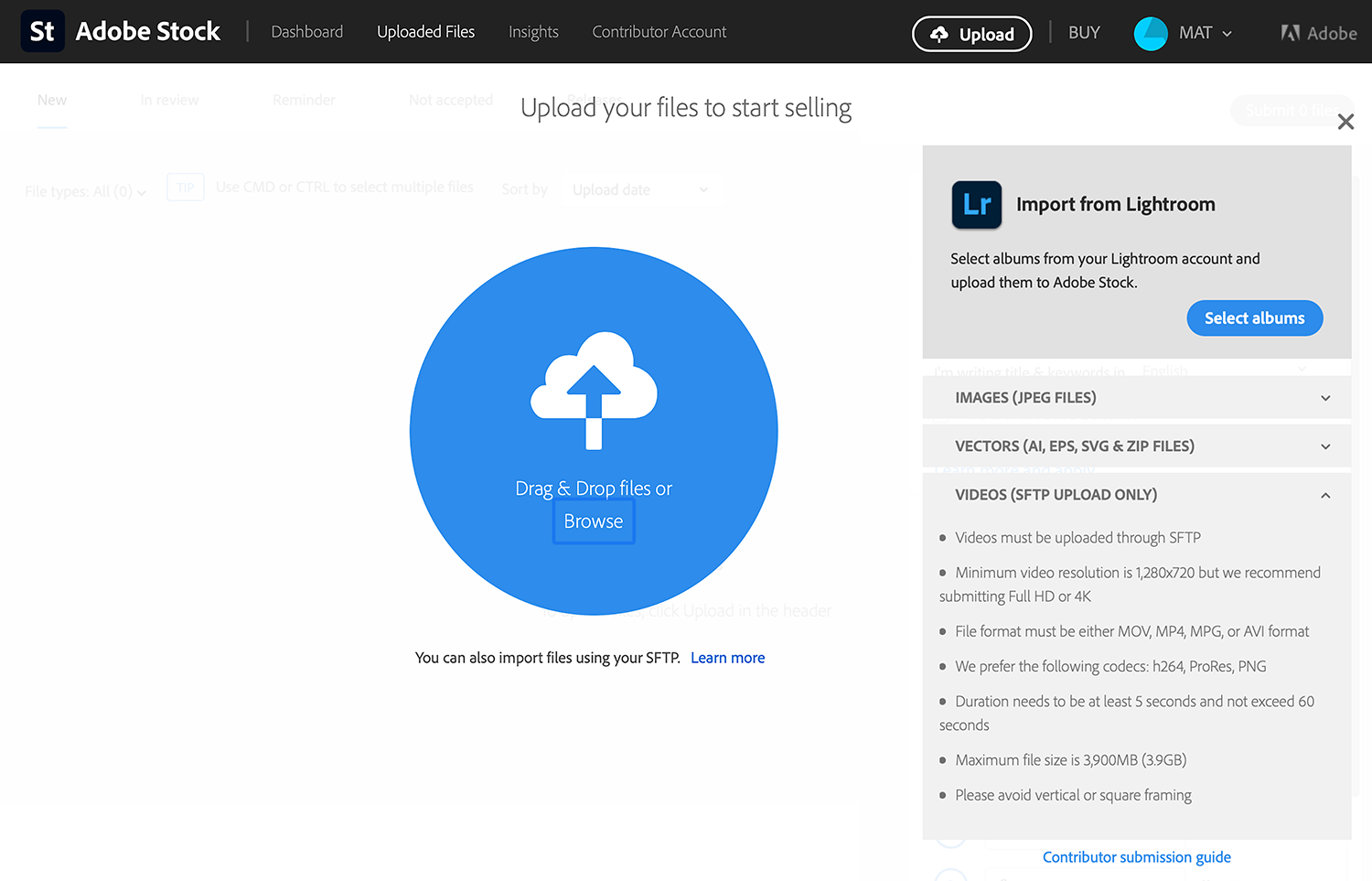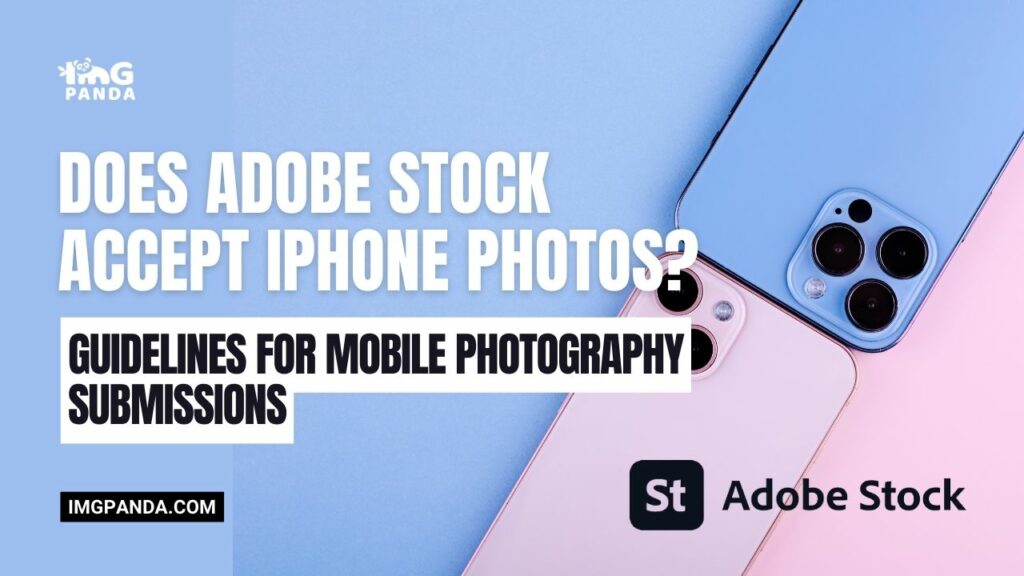Introduction
The world of photography has undergone a remarkable transformation with the advent of smartphones, placing powerful cameras right at our fingertips. Gone are the days when high-quality photography was the exclusive domain of professional cameras and extensive equipment. Today, the convenience and accessibility of smartphone cameras, particularly the popular iPhone, have sparked a revolution in mobile photography. As this trend continues to gain momentum, many creative individuals are now wondering about the possibilities of showcasing their iPhone-captured moments on platforms like Adobe Stock.
In this blog post, we'll explore the exciting question: Does Adobe Stock accept iPhone photos? We'll delve into the submission guidelines specifically tailored for mobile photography submissions, shedding light on the technical requirements, composition considerations, and essential legal aspects. Whether you're an aspiring photographer or an enthusiastic iPhone user with a passion for capturing stunning visuals, this blog post aims to provide you with the knowledge you need to navigate the world of mobile photography on Adobe Stock. Let's embark on this journey to uncover the potential and guidelines for sharing your iPhone's photographic brilliance with a broader audience.
Also Read This: Exploring YouTubers Who Call Texas Home
Adobe Stock: Overview and Benefits
Before we dive into the details of submitting iPhone photos to Adobe Stock, it's essential to understand what Adobe Stock is and the significant benefits it offers to both photographers and users seeking high-quality visual content.
What is Adobe Stock?
Adobe Stock is a renowned stock photography platform powered by Adobe, a name synonymous with creativity and design. It's a part of the Adobe Creative Cloud suite, seamlessly integrated with popular software like Adobe Photoshop, Illustrator, and InDesign. This integration makes it incredibly convenient for designers, marketers, and content creators to access a vast library of royalty-free images, videos, illustrations, and templates directly within their creative projects.
Benefits of Contributing to Adobe Stock
As a contributor to Adobe Stock, you become part of a dynamic ecosystem that offers several advantages:
- Exposure: Adobe Stock has a vast user base, including professionals, businesses, and creative individuals. Your photos have the potential to reach a global audience, gaining exposure that might not have been possible otherwise.
- Earning Potential: Adobe Stock provides a platform for photographers to monetize their work. When your photos are downloaded by users, you receive a royalty, which can be a valuable source of income, especially as your portfolio grows.
- Integration with Creative Cloud: If you're already using Adobe Creative Cloud applications, contributing to Adobe Stock becomes seamless. You can directly submit your work from within these applications, streamlining your workflow.
- Diverse Content Categories: Adobe Stock caters to various content categories, including lifestyle, travel, business, nature, and more. This diversity allows you to explore your creative interests and find your niche within the platform.
- Professional Development: The submission process and interaction with Adobe Stock reviewers can provide valuable insights into improving your photography skills. Constructive feedback can be a catalyst for growth, refining your abilities over time.
- Respect for Your Copyright: Adobe Stock ensures that you retain the copyright to your images. Users can download and use your work based on the licensing terms you've set, giving you control over how your photos are utilized.
- Networking: Being part of the Adobe Stock community means connecting with other contributors, sharing experiences, and learning from one another. This networking can be inspiring and can lead to exciting collaborations.
[caption id="attachment_192110" align="alignnone" width="1280"] Adobe Stock Overview and Benefits[/caption]
Adobe Stock Overview and Benefits[/caption]
Also Read This: Deleting My 123RF Account: Step-by-Step
Mobile Photography: A Growing Trend
In recent years, mobile photography has emerged as a powerful and rapidly growing trend within the realm of visual content creation. The ubiquity of smartphones, particularly the high-quality cameras found in devices like the iPhone, has democratized photography, making it accessible to millions of people worldwide. Let's take a closer look at the factors contributing to the meteoric rise of mobile photography and why it's a trend that can't be ignored.
Evolution of Smartphone Cameras
Mobile photography has come a long way since the first generation of camera-equipped smartphones. Early models struggled with low-resolution images and limited capabilities. However, the relentless advancements in smartphone camera technology have been nothing short of remarkable. With each new iteration, smartphone cameras have improved in terms of image quality, low-light performance, dynamic range, and overall versatility.
The iPhone, in particular, has been at the forefront of this evolution, consistently pushing the boundaries of what a compact camera system can achieve. It's no longer unusual to capture stunning landscapes, vibrant portraits, or intricate macro shots using just your smartphone.
Convenience and Accessibility
One of the primary drivers behind the surge in mobile photography is the sheer convenience and accessibility of smartphone cameras. Unlike traditional cameras, which may require bulky equipment and a steep learning curve, smartphones are compact, always within arm's reach, and user-friendly. This accessibility has encouraged more people to experiment with photography, fostering a community of amateur and aspiring photographers.
Additionally, the instant sharing capabilities of smartphones have transformed how we interact with images. Social media platforms and messaging apps allow us to share our photographs instantly, making photography a key component of modern communication and self-expression.
Empowerment of Creativity
Mobile photography empowers individuals to unleash their creativity and explore the world through a lens. People are capturing candid moments, exploring unique angles, and experimenting with creative techniques, all with the tools they carry in their pockets. This democratization of creativity has resulted in a diverse and vibrant collection of photographs, reflecting different perspectives and experiences.
Professional-Grade Editing on Mobile
The rise of mobile photography isn't just about capturing great shots; it's also about the post-processing capabilities available on smartphones. There's an abundance of powerful photo editing apps that allow users to fine-tune their images, apply filters, and even perform advanced adjustments—all without the need for a computer or expensive software. This seamless integration of photography and editing on mobile devices has further fueled the appeal of mobile photography.
A Paradigm Shift for Stock Photography
The growth of mobile photography has significantly influenced the stock photography industry. Stock agencies, including Adobe Stock, now recognize the value of high-quality mobile imagery. The ability to capture authentic, on-the-go moments with a smartphone has opened up new possibilities for stock photography, expanding the range of content that's in demand.
[caption id="attachment_192111" align="alignnone" width="1500"] Mobile Photography A Growing Trend[/caption]
Mobile Photography A Growing Trend[/caption]
Also Read This: How to Manage Job Alerts on LinkedIn for Personalized Notifications
Adobe Stock Submission Guidelines
Submitting your iPhone photos to Adobe Stock can be an exciting opportunity to showcase your mobile photography skills to a global audience. However, it's essential to adhere to Adobe Stock's submission guidelines to ensure your images meet the platform's quality standards and legal requirements. Let's explore the key aspects of these guidelines:
Technical Requirements for Mobile Photos
- Resolution and Image Quality: Adobe Stock requires high-resolution images. For mobile photos, this typically means a minimum of 4 megapixels (MP) and ideally higher. Higher resolution allows for more versatile use of your images by buyers, whether in print or digital formats.
- File Formats: Preferred file formats include JPEG or TIFF. These formats maintain image quality while minimizing file size. Adobe Stock doesn't accept images in RAW format directly from mobile devices.
- No Watermarks or Logos: Ensure that your images are free from watermarks, logos, or any other visual elements that might interfere with the image's usability for buyers.
- Noise and Artifacts: Keep an eye out for excessive noise (graininess) and digital artifacts in your images. These can detract from the overall quality of the photo.
- Focus and Sharpness: Ensure your images are in focus and sufficiently sharp. Blurry or out-of-focus photos may not meet the platform's quality standards.
Composition and Subject Matter
- Commercial Appeal: Adobe Stock primarily focuses on imagery with commercial value. Consider subjects that are visually appealing and have a broad range of potential uses, such as lifestyle, business, technology, nature, and travel.
- Candid and Natural: Authenticity is essential. Candid, natural shots often perform well on stock platforms. Capturing genuine moments can attract buyers looking for real-life scenarios.
- Avoid Trademarked Elements: Be cautious about including recognizable trademarked elements, such as brand logos or copyrighted designs, in your photos.
Legal Considerations
- Model Releases: If your images feature recognizable people, you'll need signed model releases from the individuals depicted. Adobe Stock has strict guidelines regarding the need for model releases to protect the privacy and rights of those in the photos.
- Property Releases: If your images feature private property or distinct locations, especially if it's recognizable, you'll need property releases. This applies to places where the owner's permission is required for commercial use.
- Sensitive Content: Adobe Stock has guidelines about not accepting images with sensitive or inappropriate content. Be mindful of the platform's content policy and avoid submitting images that violate these guidelines.
Remember that the submission process involves a review by Adobe Stock's team, and they're looking for images that meet high-quality standards and have commercial potential. If your images are rejected, don't be discouraged. Learn from the feedback provided and keep refining your skills to improve your chances of acceptance in the future.
[caption id="attachment_192113" align="alignnone" width="1500"] Adobe Stock Submission Guidelines[/caption]
Adobe Stock Submission Guidelines[/caption]
Also Read This: Creating Your Own Video Platform Like YouTube
Tips for Optimizing iPhone Photos
Optimizing your iPhone photos for submission to Adobe Stock involves a combination of capturing compelling images and making thoughtful edits to enhance their appeal. Here are some valuable tips to help you make the most of your iPhone photos:
1. Use the Right Apps and Settings
- Pro Camera Apps: Consider using third-party camera apps that offer manual control over settings like exposure, focus, and white balance. This can give you more creative freedom than the default iPhone camera app.
- HDR (High Dynamic Range): Enable the HDR mode when shooting scenes with high contrast between light and shadow. HDR can help preserve details in both bright and dark areas of the image.
- Gridlines: Turn on the gridlines in your camera settings to apply the rule of thirds, a common composition guideline that can enhance the visual balance of your photos.
2. Lighting and Framing
- Natural Light: Take advantage of natural light, especially during the golden hours (early morning and late afternoon). Soft, diffused light can add depth and warmth to your photos.
- Avoid Harsh Shadows: On sunny days, harsh shadows can be problematic. Use objects or structures to create shade or consider using a reflector to bounce light onto your subject.
- Experiment with Angles: Try different angles and perspectives. Get low for dramatic shots, shoot from above for interesting compositions, and experiment with unconventional framing.
3. Post-Processing for Stock
- Avoid Over-Editing: While post-processing is valuable, be cautious not to overdo it. Buyers often prefer natural-looking images. Focus on enhancing the existing qualities of the photo rather than drastically altering it.
- Crop and Straighten: Crop out distractions and straighten horizons if needed. A well-composed image can make a significant difference.
- Color Correction: Adjust the color balance if necessary. Ensure that colors appear natural and appealing, without any strong color casts.
4. Pay Attention to Composition
- Rule of Thirds: Apply the rule of thirds by placing your main subject along the lines or at the intersection points of the gridlines. This can create a visually pleasing composition.
- Leading Lines: Look for leading lines (roads, paths, fences) that guide the viewer's eye into the photo. They can add depth and draw attention to the main subject.
- Negative Space: Experiment with negative space, where the main subject is surrounded by an empty or simple background. This can create a striking and focused composition.
5. Model and Property Releases
- Collect Model Releases: If your photos feature recognizable people, ensure you have signed model releases from them. Model releases are essential for commercial use.
- Property Releases: Obtain property releases for images featuring private property or distinct locations. This is crucial for images that may require the owner's permission for commercial use.
By carefully applying these tips, you'll be better equipped to create iPhone photos that not only meet Adobe Stock's submission guidelines but also have the potential to stand out, attract buyers, and contribute to your success as a mobile photographer on the platform. Remember to keep learning, practicing, and refining your skills to continually improve the quality of your work.
15 Flower Photography Tips for Gorgeous Results https://t.co/F62p1ISgye pic.twitter.com/klzyU0fG55
— Iphone Photography (@IphonePhotoShot) August 7, 2023
Also Read This: Wrap Up Your Reading with Canva Reading Wrap-Up Template
Submission Process
The submission process for Adobe Stock involves a series of steps to ensure that your iPhone photos meet the platform's quality standards and legal requirements. Follow these steps to successfully submit your images:
1. Prepare Your Images
- Select the best images from your iPhone photography collection. Choose high-resolution photos that showcase a variety of subjects and styles.
- Review your images for technical quality, composition, and adherence to Adobe Stock guidelines. Make any necessary edits to improve the overall appeal of the photos.
2. Check Legal Requirements
- Ensure that you have obtained all necessary model releases for images featuring recognizable people. If your photos include individuals, you must have their written consent.
- If your images feature private property or recognizable locations, make sure you have the required property releases. This is essential for images that may require the owner's permission for commercial use.
3. Log into Adobe Stock Contributor Portal
- If you're not already a contributor, sign up for an Adobe Stock contributor account. If you're already a contributor, log in to the Adobe Stock Contributor portal using your credentials.
4. Submit Your Images
- Navigate to the "Upload Files" section within the Contributor portal. Here, you can upload your iPhone photos directly from your computer.
- Follow the prompts to select the files you wish to submit. You can choose multiple images for a single submission, making the process efficient.
5. Keyword and Categorize
- For each image, provide relevant keywords that describe the content. These keywords help potential buyers discover your photos when searching the Adobe Stock library.
- Select appropriate categories for your images. Accurate categorization improves the visibility of your photos within specific niches.
4. Review and Metadata
- Review the information you've provided, including keywords and categories, to ensure accuracy. This step is crucial for making your images easily discoverable by buyers.
- Ensure that your images have appropriate metadata, including titles and descriptions. Clear and concise metadata can enhance the understanding of your photos.
7. Submit for Review
- Once you've completed the necessary steps, submit your images for review by the Adobe Stock team.
8. Review and Acceptance
- Adobe Stock will review your submissions for technical quality, composition, and compliance with guidelines. This review process may take some time, and you'll be notified of the results via email.
- If your images are accepted, they will be made available in the Adobe Stock library for potential buyers to license.
9. Learn from Feedback
- If any of your images are rejected, carefully review the feedback provided by Adobe Stock. Use this feedback as a learning opportunity to improve your future submissions.
Remember that the submission process may require some patience, especially during the review phase. Stay engaged, continue refining your photography skills, and consider resubmitting improved versions of rejected images in the future. Building a strong portfolio on Adobe Stock takes time, persistence, and a commitment to quality.
Here's the video showcasing 6 tips and tricks for iPhone photography!
Also Read This: Getting clients from Behance
Conclusion
In conclusion, the world of mobile photography has been revolutionized by the accessibility and capabilities of smartphones, particularly the beloved iPhone. Adobe Stock, a prominent platform for creative content, provides a golden opportunity for iPhone photographers to share their visual narratives with a global audience and even earn from their craft. By following the guidelines and best practices we've discussed, you can harness the power of mobile photography and successfully contribute to Adobe Stock.
Remember that while the technical aspects of image quality and composition are crucial, equally important is your creative eye. Capture the beauty of everyday moments, tell compelling stories, and explore different styles to showcase the versatility of mobile photography.
Additional Resources
1. Adobe Stock Contributor Portal:
Visit the official Adobe Stock Contributor portal for detailed information on submission guidelines, licensing terms, and updates on the submission process. This portal is your go-to source for the latest information directly from Adobe.
2. Photography Tutorials and Learning Platforms:
Explore online tutorials and courses to improve your photography skills, composition techniques, and post-processing abilities. Platforms like Udemy, Coursera, and YouTube offer a wide range of photography courses, including mobile photography-specific content.
3. Photography and Stock Photography Forums:
Join photography communities and forums where you can interact with other photographers, share your experiences, ask questions, and gain insights into the world of stock photography. Websites like DPReview and Photography Stack Exchange can be valuable resources.
4. Adobe Stock Blog:
Stay updated with the latest news, trends, and tips related to stock photography on the Adobe Stock Blog. It's a valuable resource for contributors, offering insights into what buyers are looking for, creative inspiration, and contributor success stories.
5. Photography Books:
Explore renowned photography books that cover various aspects of photography, from composition and lighting to storytelling and image editing. Some popular titles include "Understanding Exposure" by Bryan Peterson and "The Photographer's Eye" by Michael Freeman.
6. Social Media and Photography Communities:
Follow photography-related accounts on social media platforms like Instagram, Twitter, and Facebook. Engage with fellow photographers, learn from their experiences, and participate in photo challenges to hone your skills.
7. Photography Apps and Editing Tools:
Experiment with photo editing apps to enhance your images. Popular apps like Adobe Lightroom Mobile, Snapseed, and VSCO can provide advanced editing capabilities right on your smartphone.
8. Photography Exhibitions and Galleries:
Visit local photography exhibitions and galleries to immerse yourself in the work of established photographers. Studying different styles, themes, and techniques can inspire your own photography journey.
9. Creative Commons and Licensing Education:
Familiarize yourself with Creative Commons licenses and the basics of copyright and licensing in the creative industry. Understanding these concepts is crucial for navigating the world of stock photography.
10. Continuous Learning and Practice:
Keep an open mind, embrace new challenges, and never stop learning. Consistent practice, learning from feedback, and pushing your creative boundaries are key to your growth as a mobile photographer and contributor to Adobe Stock.
By utilizing these additional resources, you'll be well-equipped to refine your skills, navigate the submission process with confidence, and make the most of your journey as a mobile photographer on Adobe Stock. Happy shooting!
